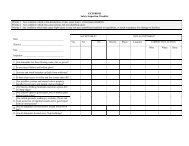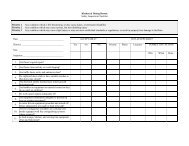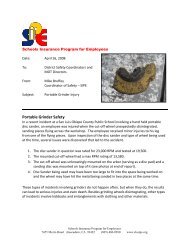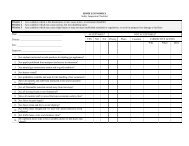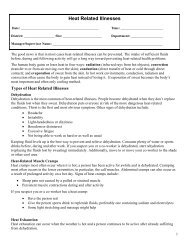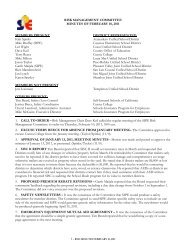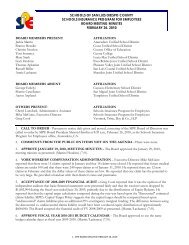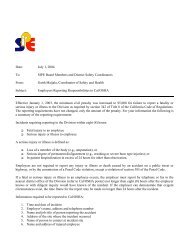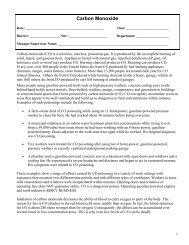MSDS – Material Safety Data Sheet - sipe
MSDS – Material Safety Data Sheet - sipe
MSDS – Material Safety Data Sheet - sipe
You also want an ePaper? Increase the reach of your titles
YUMPU automatically turns print PDFs into web optimized ePapers that Google loves.
<strong>MSDS</strong> <strong>–</strong> <strong>Material</strong> <strong>Safety</strong> <strong>Data</strong> <strong>Sheet</strong><br />
Date: ______________________________________________<br />
District: __________________ Site: _______________________<br />
Time: _________________________<br />
Department: ___________________<br />
Manager/Supervisor Name: _________________________________________________________________<br />
<strong>Material</strong> <strong>Safety</strong> <strong>Data</strong> <strong>Sheet</strong> (<strong>MSDS</strong>) is a short technical report that provides you with the known hazards of a specific<br />
material. They are written by chemical manufacturers for chemicals they produce or import. The purpose of a <strong>MSDS</strong><br />
is to provide written information for the safe use and handling of a particular chemical. They may be written in<br />
different forms, but all are required to give you the following basic information:<br />
‣ Identification (chemical and physical)<br />
‣ Hazardous Ingredients<br />
‣ Physical and Chemical Characteristics<br />
‣ Emergency Procedures<br />
‣ First Aid or Medical Procedures<br />
‣ Manufacturer's Name, Address and Phone Number<br />
‣ Health Hazards<br />
‣ Physical Hazards (fire and explosion data)<br />
‣ Reactivity <strong>Data</strong><br />
‣ Personal Protection <strong>Data</strong><br />
‣ Spill and Leak Procedures<br />
‣ Waste Disposal Methods<br />
State and Federal laws require that each employer keep these <strong>MSDS</strong> available at the work site for any hazardous<br />
chemical that you work with. Check with your supervisor for the location of the <strong>MSDS</strong> file on your job. Be sure to<br />
read the <strong>MSDS</strong> prior to working with any unfamiliar chemical to inform you of any hazards, and then follow all the<br />
manufacturer's recommendations. A Hazardous <strong>Material</strong> is any substance which is potentially toxic, incompatible<br />
with other substances, corrosive, explosive, flammable or combustible, or poses unusual physical hazards under<br />
normal use conditions or emergencies. Look at the label on chemical containers. If you see words like:<br />
‣ FLAMMABLE<br />
‣ DANGER<br />
‣ COMBUSTIBLE<br />
‣ HAZARDOUS<br />
‣ POISON<br />
‣ CAUTION<br />
‣ WARNING<br />
Then you know a <strong>MSDS</strong> is required. The <strong>MSDS</strong> will help you work safely with chemicals, but only if you read it!<br />
1
<strong>Safety</strong> Procedures<br />
The material safety data sheet is a great source of information on the chemicals we use and, most important, on how<br />
you can use them safely.<br />
A lot of work goes into creating these sheets and to making sure that we have a full set available for your reference.<br />
But all of that is worthless unless you use them.<br />
So always start your preparation for a job involving a hazardous chemical with these three steps:<br />
1) Read the container label.<br />
2) Read the material safety data sheet.<br />
3) Follow the instructions and precautions on the material safety data sheet.<br />
Suggested Discussion Questions<br />
1) What is the purpose of the material safety data sheet?<br />
2) When do you refer to the material safety data sheet?<br />
3) Where do we keep material safety data sheets?<br />
4) What are some examples of substances we use that require checking <strong>MSDS</strong>s?<br />
5) What are some examples of jobs you do that require checking <strong>MSDS</strong>s<br />
6) What are the four ways a chemical can get into your body?<br />
7) Is the <strong>MSDS</strong> binder current and up-to-date?<br />
Provide a copy of a <strong>MSDS</strong> for a currently used workplace chemical to each person and go through<br />
each section, highlighting the most important information<br />
Suggested SIPE <strong>Safety</strong> Videos:<br />
18-9 HAZMAT Program <strong>–</strong> Employee Right to Know (30 minutes)<br />
18-10 Chemical <strong>Safety</strong> <strong>–</strong> Worker Health & <strong>Safety</strong> (15 minutes)<br />
18-11 Hazard Communications 2000 (27 minutes)<br />
144 HAZCOM <strong>–</strong> Labels and <strong>MSDS</strong>’s (8 minutes)<br />
225 HAZCOM - Using <strong>MSDS</strong>’s (12 minutes)<br />
2




